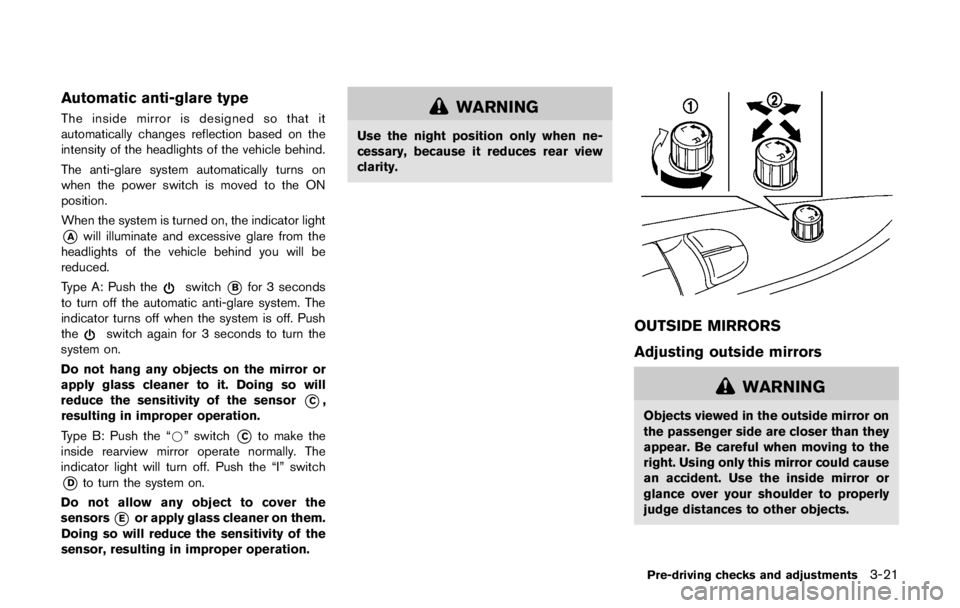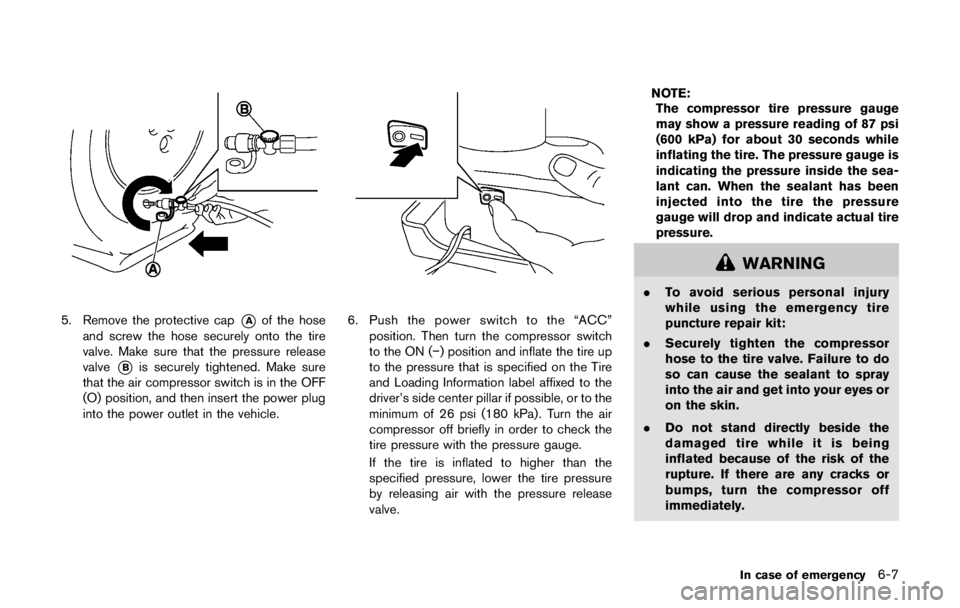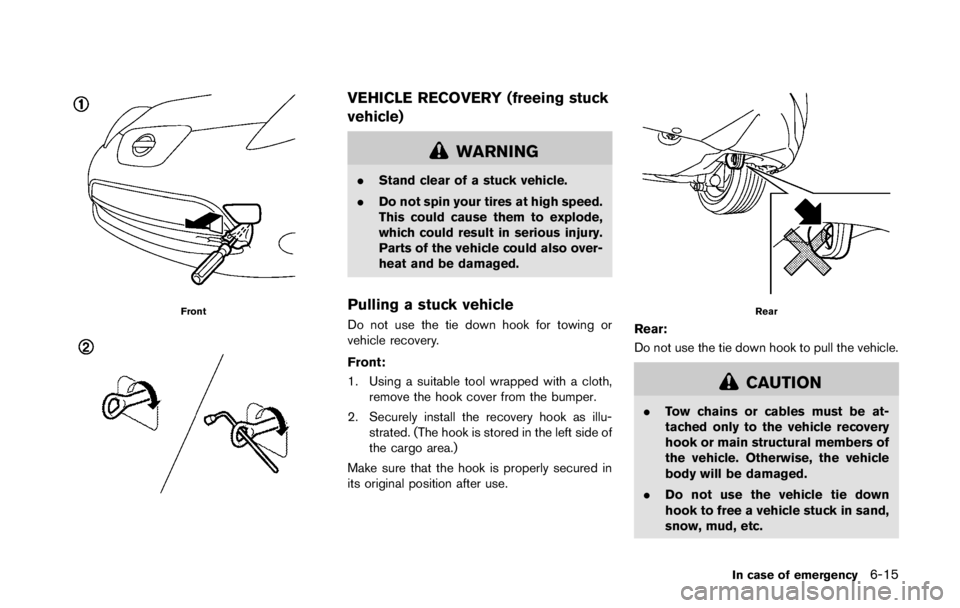2011 NISSAN LEAF warning lights
[x] Cancel search: warning lightsPage 203 of 1062

2 Instruments and controls
Cockpit ....................................................................................... 2-3
Instrument panel ....................................................................... 2-4
Meters and gauges .................................................................. 2-5Speedometer and odometer ........................................... 2-6
Li-ion battery temperature gauge ................................... 2-7
Power meter ........................................................................ 2-7
Driving range ....................................................................... 2-8
Li-ion battery available charge gauge ........................... 2-9
Li-ion battery capacity level gauge ............................. 2-10
Outside air temperature ................................................ 2-10
ECO indicator .................................................................. 2-10
Clock .................................................................................. 2-11
Warning/indicator lights and audible reminders ........... 2-12
Checking bulbs ................................................................ 2-13
Warning lights .................................................................. 2-13
Indicator lights .................................................................. 2-18
Audible reminders ........................................................... 2-20
Dot matrix liquid crystal display ......................................... 2-22 Indicators for operation .................................................. 2-23
Trip computer ................................................................... 2-27
Warning information displays ....................................... 2-31
Indicators for maintenance ........................................... 2-33
Indicator for timer ............................................................ 2-34 Security systems .................................................................. 2-35
Vehicle security system ............................................... 2-35
NISSAN Vehicle Immobilizer System ....................... 2-36
Windshield wiper and washer switch ............................. 2-38 Washer operation ......................................................... 2-39
Rear window wiper and washer switch ........................ 2-39
Rear window and outside mirror defroster switch ...... 2-40
Instrument brightness control ............................................ 2-41
Headlight and turn signal switch ...................................... 2-41 Headlight switch ........................................................... 2-41
Turn signal switch ......................................................... 2-44
Fog light switch (if so equipped) ..................................... 2-44
Hazard warning flasher switch .......................................... 2-45
Heated steering wheel (if so equipped) ........................ 2-45
Horn ......................................................................................... 2-46
Heated seats (if so equipped) .......................................... 2-47
Vehicle Dynamic Control (VDC) OFF switch ................ 2-48
Power outlet ........................................................................... 2-49
Storage ................................................................................... 2-49 Cup holders .................................................................... 2-49
Sunglasses holder ........................................................ 2-50
Glove box ........................................................................ 2-51Console box ................................................................... 2-51
Page 220 of 1062

0 Illustrated table of contents
Seats, seat belts and Supplemental Restraint
System (SRS) ........................................................................... 0-2
Exterior front .............................................................................. 0-3
Exterior rear ............................................................................... 0-4
Passenger compartment ........................................................ 0-5 Cockpit ....................................................................................... 0-6
Instrument panel ...................................................................... 0-7
Meters and gauges ................................................................. 0-8
Motor compartment ................................................................ 0-9
Warning and indicator lights ............................................. 0-10
Page 238 of 1062

EMERGENCY SHUT-OFF SYSTEM
The emergency shut-off system is activated and
the high-voltage system automatically turns off in
the following conditions:
- Front and side collisions in which the air bags
are deployed.
- Certain rear collisions.
- Certain EV (Electric Vehicle) system malfunc-
tions
For the above collisions and certain other EV
(Electric Vehicle) system malfunctions, the
READY to drive indicator light will turn off. See
“Warning/indicator lights and audible remin-
ders” in the “2. Instruments and controls”
section.
The emergency shut-off activates for the above
collisions to minimize risk of an event that could
cause injury or an accident. If the emergency
shut-off system activates, the EV system may
not be switched to READY to drive position,
contact a NISSAN certified LEAF dealer. Even if
the power switch is switched to READY to drive
position, the system may shut-off suddenly.
Therefore, drive cautiously to the nearest
NISSAN certified LEAF dealer or contact a
NISSAN certified LEAF dealer as soon as
possible.WARNING
.Pay special attention to pedes-
trians. Because there is no engine
noise, pedestrians may not know
the vehicle is approaching, moving
or about to move, and may step into
the path of vehicle travel.
. When leaving the vehicle, be sure to
turn off the EV (Electric Vehicle)
system.
. Be sure to push the P (Park) posi-
tion switch on the selector lever and
apply the parking brake when park-
ing because the vehicle can move
when the READY to drive indicator
light is ON. When the READY to
drive indicator light is ON, do not
leave your vehicle in a shift position
other than the P (Park) position.
. Keep the brake pedal depressed
until you are ready to drive. When
the vehicle is in the D (drive) posi-
tion or ECO or R (reverse) position,
if you release the brake pedal and
do not depress accelerator, the
vehicle will creep and may start
abruptly. This may cause serious injury or death.
NOTE:
. The vehicle cannot run with a dis-
charged Li-ion battery. Repeated accel-
eration consumes more power from the
Li-ion battery than driving at a steady
speed.
. This vehicle is equipped with a regen-
erative brake system. The primary pur-
pose of regenerative brake system is to
provide some power to recharge the Li-
ion battery and extend driving range. A
secondary benefit is “engine braking”
that operates based on Li-ion battery
conditions.
. In the D (Drive) position, when the
accelerator pedal is released, the re-
generative brake system provides
some deceleration.
. When you put the shift selector in the
ECO position and take your foot off the
accelerator pedal, more regenerative
brake is applied than in the D (Drive)
position.
. Less deceleration is provided by the
regenerative brake system when the Li-
EV OverviewEV-9
EV (Electric Vehicle)
CHARACTERISTICS
Page 270 of 1062

0 Illustrated table of contents
Seats, seat belts and Supplemental Restraint
System (SRS) ........................................................................... 0-2
Exterior front .............................................................................. 0-3
Exterior rear ............................................................................... 0-4
Passenger compartment ........................................................ 0-5 Cockpit ....................................................................................... 0-6
Instrument panel ...................................................................... 0-7
Meters and gauges ................................................................. 0-8
Motor compartment ................................................................ 0-9
Warning and indicator lights ............................................. 0-10
Page 278 of 1062

EMERGENCY SHUT-OFF SYSTEM
The emergency shut-off system is activated and
the high-voltage system automatically turns off in
the following conditions:
- Front and side collisions in which the air bags
are deployed.
- Certain rear collisions.
- Certain EV (Electric Vehicle) system malfunc-
tions
For the above collisions and certain other EV
(Electric Vehicle) system malfunctions, the
READY to drive indicator light will turn off. See
“Warning/indicator lights and audible remin-
ders” in the “2. Instruments and controls”
section.
The emergency shut-off activates for the above
collisions to minimize risk of an event that could
cause injury or an accident. If the emergency
shut-off system activates, the EV system may
not be switched to READY to drive position,
contact a NISSAN certified LEAF dealer. Even if
the power switch is switched to READY to drive
position, the system may shut-off suddenly.
Therefore, drive cautiously to the nearest
NISSAN certified LEAF dealer or contact a
NISSAN certified LEAF dealer as soon as
possible.WARNING
.Pay special attention to pedes-
trians. Because there is no engine
noise, pedestrians may not know
the vehicle is approaching, moving
or about to move, and may step into
the path of vehicle travel.
. When leaving the vehicle, be sure to
turn off the EV (Electric Vehicle)
system.
. Be sure to push the P (Park) posi-
tion switch on the selector lever and
apply the parking brake when park-
ing because the vehicle can move
when the READY to drive indicator
light is ON. When the READY to
drive indicator light is ON, do not
leave your vehicle in a shift position
other than the P (Park) position.
. Keep the brake pedal depressed
until you are ready to drive. When
the vehicle is in the D (drive) posi-
tion or ECO or R (reverse) position,
if you release the brake pedal and
do not depress accelerator, the
vehicle will creep and may start
abruptly. This may cause serious injury or death.
NOTE:
. The vehicle cannot run with a dis-
charged Li-ion battery. Repeated accel-
eration consumes more power from the
Li-ion battery than driving at a steady
speed.
. This vehicle is equipped with a regen-
erative brake system. The primary pur-
pose of regenerative brake system is to
provide some power to recharge the Li-
ion battery and extend driving range. A
secondary benefit is “engine braking”
that operates based on Li-ion battery
conditions.
. In the D (Drive) position, when the
accelerator pedal is released, the re-
generative brake system provides
some deceleration.
. When you put the shift selector in the
ECO position and take your foot off the
accelerator pedal, more regenerative
brake is applied than in the D (Drive)
position.
. Less deceleration is provided by the
regenerative brake system when the Li-
EV OverviewEV-9
EV (Electric Vehicle)
CHARACTERISTICS
Page 291 of 1062

4. When activated, the hazard warning lightswill flash twice. When deactivated, the
hazard warning lights will flash once.
5. The power switch must be placed in the OFF and ON position again between each
setting change.
When the automatic door unlock system is
deactivated, the doors do not unlock when the
power is placed in the OFF position. To unlock
the door manually, use the inside lock knob or
the power door lock switch (driver’s or front
passenger’s side).
Page 401 of 1062

4. When activated, the hazard warning lightswill flash twice. When deactivated, the
hazard warning lights will flash once.
5. The power switch must be placed in the OFF and ON position again between each
setting change.
When the automatic door unlock system is
deactivated, the doors do not unlock when the
power is placed in the OFF position. To unlock
the door manually, use the inside lock knob or
the power door lock switch (driver’s or front
passenger’s side).
Page 486 of 1062

8 Maintenance and do-it-yourself
Maintenance requirement ....................................................... 8-2Scheduled maintenance ................................................... 8-2
General maintenance ........................................................ 8-2
Where to go for service ................................................... 8-2
General maintenance .............................................................. 8-2 Explanation of maintenance items ................................. 8-2
Maintenance precautions ....................................................... 8-4
Motor compartment check locations .................................. 8-6
Cooling system ......................................................................... 8-7 Checking coolant level ..................................................... 8-8
Changing coolant ............................................................... 8-8
Reduction gear fluid ................................................................ 8-9
Brake fluid .................................................................................. 8-9
Window washer fluid ........................................................... 8-10
12-volt battery ........................................................................ 8-11 Jump starting .................................................................... 8-12
Windshield wiper blades .................................................... 8-12 Cleaning ............................................................................ 8-12 Replacing ........................................................................ 8-12
Rear window wiper blade .................................................. 8-15
Brakes ..................................................................................... 8-15
Brake pad wear warning ............................................. 8-15
Fuses ....................................................................................... 8-16 Motor compartment ...................................................... 8-16
Passenger compartment ............................................. 8-17
Intelligent Key battery replacement .................................. 8-18
Lights ....................................................................................... 8-20 Headlights ....................................................................... 8-21
Exterior and interior lights ........................................... 8-22
Wheels and tires .................................................................. 8-25 Tire pressure .................................................................. 8-25
Tire labeling .................................................................... 8-28
Types of tires .................................................................. 8-30
Tire chains ...................................................................... 8-31
Changing wheels and tires ......................................... 8-32
Emergency tire puncture repair kit ........................... 8-34